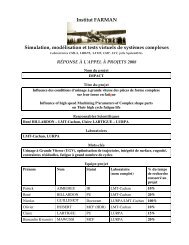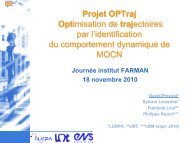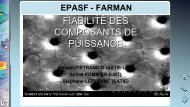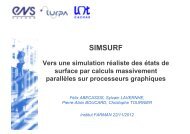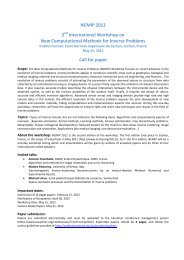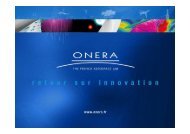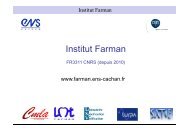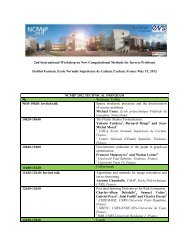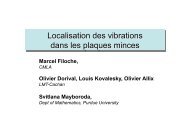DIGISCOPE 2010 Acronyme du projet - Institut Farman - ENS Cachan
DIGISCOPE 2010 Acronyme du projet - Institut Farman - ENS Cachan
DIGISCOPE 2010 Acronyme du projet - Institut Farman - ENS Cachan
Create successful ePaper yourself
Turn your PDF publications into a flip-book with our unique Google optimized e-Paper software.
APPEL A PROJETS EQUIPEX /<br />
CALL FOR PROPOSALS<br />
<strong>2010</strong><br />
<strong>DIGISCOPE</strong><br />
SCIENTIFIC SUBMISSION FORM B<br />
CMLA will be the lead laboratory in <strong>DIGISCOPE</strong>. It brings together 35 researchers, 30 PhD<br />
students, 12 postdocs or research lecturers, 7 technical and administrative staff. The<br />
specificity of the CMLA lies in the multidisciplinarity of its members and in the effective<br />
aspect of the work done in an in<strong>du</strong>strial context. Modeling and numerical simulation play a<br />
role at least as important as mathematical analysis. Any new phenomenon of nature,<br />
technology or mind, is an opportunity for the CMLA's researchers to develop mathematical<br />
models, then to simulate on a computer and finally to achieve a practical application. The<br />
mathematical techniques developed and used come from many areas: PDEs, probabilities<br />
and statistics of course, but also from classical analysis, geometry, algorithmics, and so on.<br />
The policy of the CMLA is to con<strong>du</strong>ct high-level theoretical research while remaining close<br />
to the needs of in<strong>du</strong>stry without hesitating to explore the complexity of phenomena and to<br />
move away from academic models. Two major research themes emerge in the CMLA. The<br />
first one is the scientific computation for partial differential equations used in physics and in<br />
fluid mechanics and the other one is the processing and analysis of signals and images.<br />
Maison de la Simulation<br />
With the fast spreading of large computing centers at both the national and European levels,<br />
the French research community now has access to a world leading computing infrastructure.<br />
Such an infrastructure should foster major advances in both fundamental research and<br />
technology. Nevertheless, in order to meet these goals, it is necessary to develop applications<br />
software adapted to a very high degree of parallelism. These high-end applications can only<br />
be developed by gathering multidisciplinary teams, composed of HPC engineers, software<br />
and application specialists. For this reason, the Maison de la Simulation was created under<br />
the joint impulsion of CEA and CNRS. Its main goal is to promote the efficient use by the<br />
scientific community of the available computing infrastructure. For that purpose, the Maison<br />
de la Simulation is developing along three main axes:<br />
• A multidisciplinary research centre dedicated to numerical simulation;<br />
• A service and expertise centre open to the scientific community;<br />
• A nerve centre for e<strong>du</strong>cation and scientific animation.<br />
With the power of supercomputers increasing exponentially, the simulation of complex<br />
systems at higher spatial and temporal resolution pro<strong>du</strong>ces very large and complex datasets.<br />
The analysis, exploration and proper understanding of these datasets is a major issue.<br />
Visualization tools should transform complex datasets into readily understandable images;<br />
they should also allow easy exploration and the discovery of regions of particular physical<br />
interest. For this purpose, stereoscopic display and multi-windowing, which allow<br />
visualizing simultaneously several physical properties of the same region, are particularly<br />
useful especially if they can be used in a collaborative manner.<br />
The members of Maison de la Simulation have a long experience in scientific visualization.<br />
They have developed high performance visualization tools, especially for stereoscopic vision.<br />
These tools have been used by many scientists and have contributed to numerous<br />
publications. One of their stereoscopic movies was shown for 6 months at two science<br />
museums in Paris, Palais de la Découverte and Cité des Sciences. The laboratories working with<br />
the Maison de la Simulation that will benefit from the visualization platform span a wide<br />
range of scientific areas: Climate science, Material science, Astrophysics, Plasmas physics<br />
and fusion science.<br />
34/95



